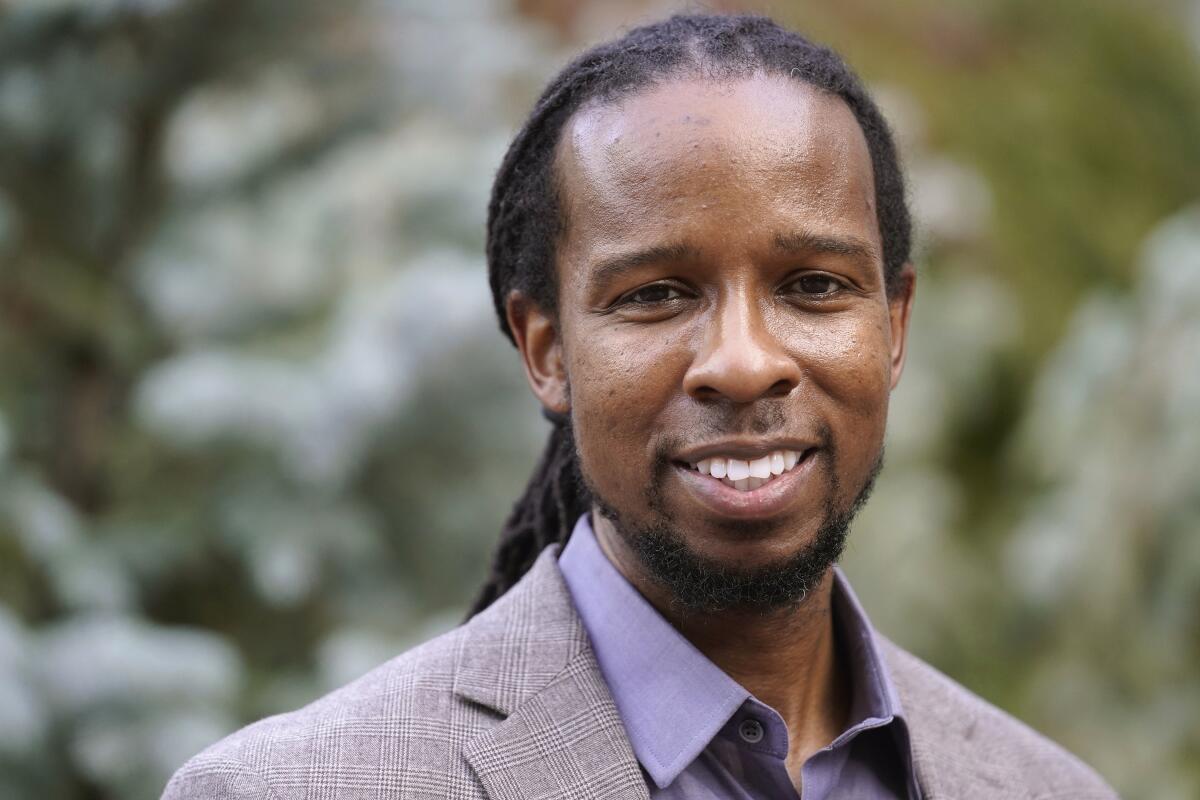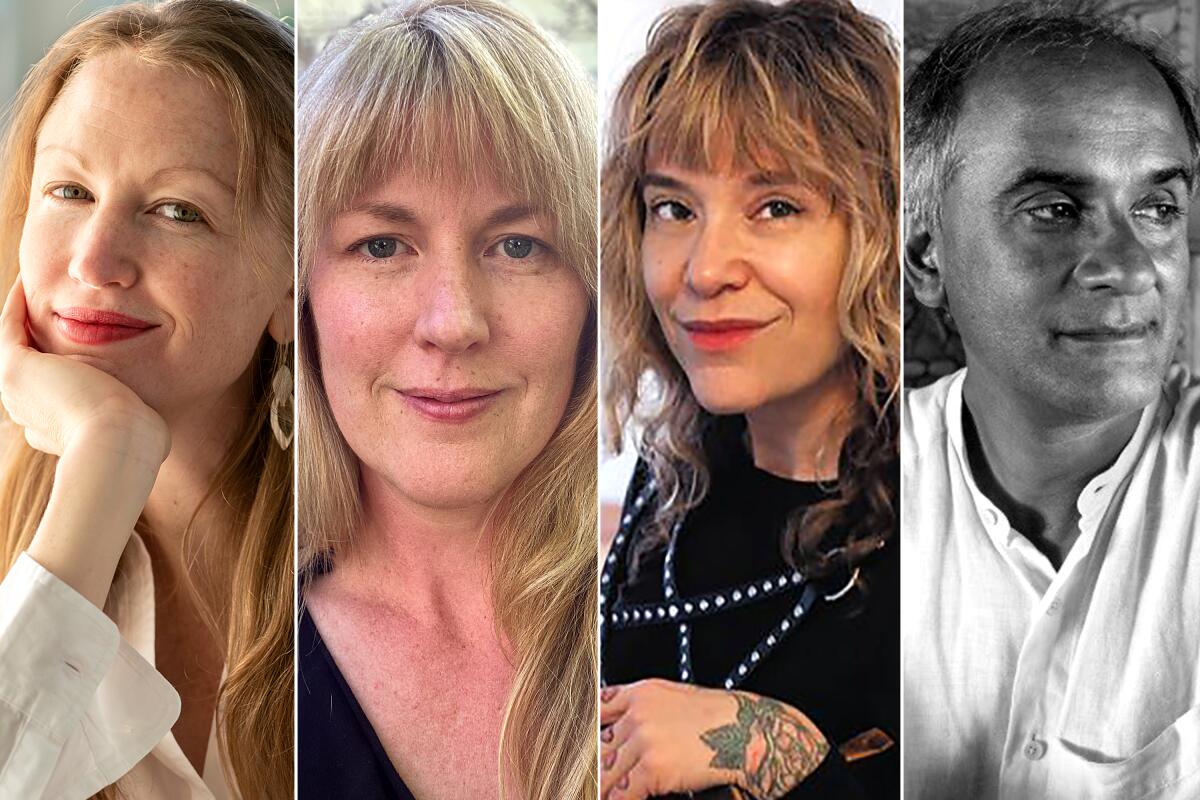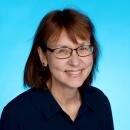Book Club: Writing through the sorrow of mass shootings

- Share via
Good morning, and welcome to the L.A. Times Book Club newsletter.
As the latest school massacre erupted in Texas, poet Amanda Gorman began writing.
Schools scared to death.
The truth is, one education under desks,
Stooped low from bullets;
That plunge when we ask
Where our children
Shall live
& how
& if
Gorman’s poem in progress went viral on social media this week as the nation struggled to grasp the horror of 19 children and two teachers gunned down inside their classroom — just days after shootings at a Buffalo, N.Y., market and a Laguna Woods church.
The 24-year-old Los Angeles poet didn’t stop with words. Gorman, the nation’s youngest inaugural poet and our April book club author, also used her platform to take action, raising money on Instagram for the Everytown for Gun Safety campaign.
“The truth is, one nation under guns,” she tweeted.
Times columnist and author Steve Lopez also begged readers: Don’t look away this time.
“Think about those innocent children in Texas, and don’t let them out of your mind,” Lopez writes. “May they rest in peace, and may we rise up in their name.”
So much sorrow
Columnist Anita Chabria spoke with historian and author Ibram X. Kendi about his new book, “How to Raise an Antiracist,” two days after the May 14 Buffalo shooting.
A young white supremacist, prosecutors say, meticulously planned to kill as many Black people as he could while they shopped for groceries on a Saturday afternoon. Ten people died, and three others were hospitalized.
Chabria notes that the 18-year-old accused of the carnage left behind a manifesto that singled out not only Black people but also mixed-race marriages — and the children of them — as something to be eliminated.
“Few of us were shocked, but for me, the mother of two mixed-race girls, the Buffalo shooting and Kendi’s book collided in a painful and deeply personal way I didn’t expect,” she writes.
Kendi told Chabria he wished he “did not feel so compelled” to write this book — “that it was unnecessary.”
But even recent events hadn’t shaken Kendi’s belief that parents could create secure environments and better outcomes for their children.
“That’s the very reason why the fundamental argument of the book is that to raise a child to be antiracist is to protect that child,” Kendi said. “There’s so many white children who are being indoctrinated into racist ideas and then hurting other people, killing other people, when they come of age as adults — just as you have many children of color who are thinking that there’s something wrong with themselves, or are the victims of those who believe in racist ideas.”
Kendi will join our next book club night, June 22 in Los Angeles at USC’s Bovard Auditorium, to discuss “How to Raise an Antiracist.”
The book is geared toward parents, teachers and other caregivers and addresses such questions as: How do we talk to kids about race and racism? How do we teach children to be antiracist? How are kids at different ages experiencing race?

Travel writing
On Thursday, authors Pico Iyer, Maggie Shipstead and Michelle Tea and editor Colleen Kinder joined book club readers to discuss, and read passages from, “Letter to a Stranger: Essays to the Ones Who Haunt Us.”
Iyer, Shipstead and Tea are among 65 writers who contributed essays about unforgettable encounters that altered their lives in unexpected ways. The stories are short but so powerful. In just a few pages, they transport us to wildly different destinations far and near.
The evening’s guest interviewer, Times travel writer Christopher Reynolds, led us on a fascinating trip that covered essays in the collection, as well as recent adventures around the globe and new books by Iyer, Shipstead and Tea. Watch now.
Last week, Reynolds wrote about the 101 best California experiences, one of the most read stories on the Los Angeles Times website. The response, he says, reflects how eager many people are to start traveling again this summer.

Q&A: Pico Iyer
The last book club newsletter featured interviews with “Letter to a Stranger” contributors Shipstead, Tea and Kinder.
And now we hear from travel author Iyer, who has written 15 books, including two on his adopted home, “Autumn Light” and “A Beginner’s Guide to Japan.”
Your next adventure: I’m just back from Zanzibar … and next week I head to London and New York (both unseen by me, thanks to the pandemic, for more than two years). But if I’m honest, my greatest adventures always take place at my desk.
The last book that kept you up at night: “Oh William!” by the impeccable and matchless Elizabeth Strout. For me, she is the wisest and truest writer in our language today, a perfect heir to Alice Munro and William Trevor. And suddenly, in her 60s, she’s producing fresh works almost every year, each of them radically different from the others but always calling upon the same clarity, depth and uncommonly subtle understanding of the human heart. No one knows more about all we cannot hope or claim to know. If I had more space, I’d start extolling Lauren Groff’s sensuous and visionary new novel, “Matrix,” and Frances Wilson’s wild and brilliant biography of D.H. Lawrence, “Burning Man,” each of which sent me into a kind of delirium of joy.
The writers who influenced you most: In chronicling the world, the British lineage of Somerset Maugham, Graham Greene and John le Carré; in examining the self, and our dialogue with the heavens, the great American line of Emerson, Thoreau, Melville and Emily Dickinson.
Something you discovered about yourself since the pandemic: I love to go nowhere at all. The view outside my window is beautiful, most of my transports are internal, and I never wish to take my neighborhood for granted again.
What’s not on your résumé (that says a lot about you): I’ve spent 31 years now staying with a group of Benedictine monks in Big Sur, Calif., and consider that the happiest and pretty much the most useful and rewarding thing I’ve ever done, other than marrying and raising a family.
Your next project: I have a book out at the end of this year — “The Half Known Life” — that investigates the idea of paradise as it plays out in various places of conflict (from Iran and North Korea to Jerusalem and Kashmir and Sri Lanka and inner Australia). More deeply, I — and it — try to explore and open out uncertainty, death and hope, perhaps the central themes of our pandemic years. Even more excitingly (for me, at least), I am already deep in the following book, chronicling at last, and in detail, all I’ve discovered and been transformed by in my 31 years with my homies in the monastery.
Sign up for our Book Club newsletter
Get the latest news, events and more from the Los Angeles Times Book Club, and help us get L.A. reading and talking.
You may occasionally receive promotional content from the Los Angeles Times.




